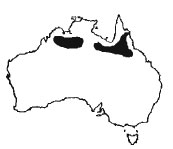Varanus Storri
Storr's goannaVaranus storri storri Mertens 1966
Varanus storri ocreatus Storr 1980.
 |
How the habitat and behaviour of this species differ from V.primordius is not yet clear. Peters (1973) found them in rocky areas with dead trees, Swanson (1976) cites dry rocky areas as their home and according to Stammer (1970) they are found in burrows under rock or spinifex. Stirnberg & Horn (1981) found them in open woodland in Queensland, sheltering under piles of rocks. Storr's goanna appears to be less arboreal in habit than V.acanthurus. According to Bustard (1970 in Greer 1989) Storr's goannas live in colonies. This is supported by Peters (1973) who found 22 specimens in O.75km2 of grassland and suggested that the total population was closer to 50 animals. They were found in individual "U"-shaped burrows under large rocks. In September the animals were most active in the morning and late afternoon, spending the hottest part of the day below ground. This lively little goanna appears to be mainly insectivorous, feeding largely on orthopterans and also taking skinks , beetles, ants and spiders (Losos & Greene 1988; James et al 1992). Peters (1973) believed they preyed heavily on geckoes. Reproduction may occur throughout the year in this species (James et al 1992). Peters, James et al and Stirnberg & Horn report that males are more commonly encountered than females.
Ritual combat in this species is probably similar to that of other dwarf goannas. Dominant males will attempt to mate with subordinate animals of either sex (Bennett 1994a). Captive breeding has been reponed many times (e.g. Mudrach 1969, Stimberg & Horn 1981, Barlett 1982, Rese 1984, Eidenmuller & Horn 1985, Flugi 1990, Eiderunuller 1994). This little monitor can do well in very small enclosures. 0.5m2 of floor area is sufficient to house a pair, but these animals are often very intolerant of each other, especially in confined surroundings. In larger enclosures (e.g. 5m2 of floor area) colonies of 6 or more adults can be housed together. Observations on captives housed outside (Bartlett 1982) suggest that given deep shelters they can tolerate temperatures as low as -6°C. Males appear to be very territorial, deterring intruders with bites to the neck, whilst females are allowed to move freely. In captivity these lizards thrive on insects dusted with vitamin and mineral powder with less · frequent feedings of small mammals or lizards. The enclosure should be as large as possible and a soft substrate provided to allow the animals to dig. Unfortunately distinguishing males from females is not easy because both sexes possess clusters of spiny scales at the edges of the vent. James et al (1992) suggest that females may reach a larger size than males. Eggs incubated at 27-31°C hatch after 72-107 days, but warmer temperatures result in fewer successful births and an incubation temperature of 27-29°C may be most suitable. Maximum clutch size is reported to be six (James et al 1992) but in captivity individual clutches never exceed four. However more than one clutch of eggs can be produced each year if the female has access to sufficient food. Hatchlings measure 4.8-5.7cm SVL (l1-14cm TL) and weigh 2.1-3.6g. Given good conditions they can reach 18g within five months and attain sexual maturity within 18 months.
Rates of water loss in Storr's goanna are similar to those reported for most other Australian varanids studied (i .e. 0.12mg of water per cm2 of skin per hour at 30°C (Green & King 1993). Sprackland (1980) noted that the colours of these animals become more intense during social interaaions and at higher temperatures. Animals housed in adjacent enclosures have been seen to wave their tails at each other (Wheeler, pers. comm.).
Attribution / Courtesy: Daniel Bennett. 1995. A Little Book of Monitor Lizards. Viper Press U.K.




